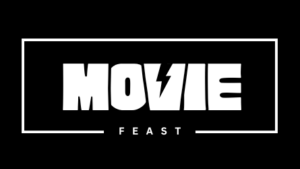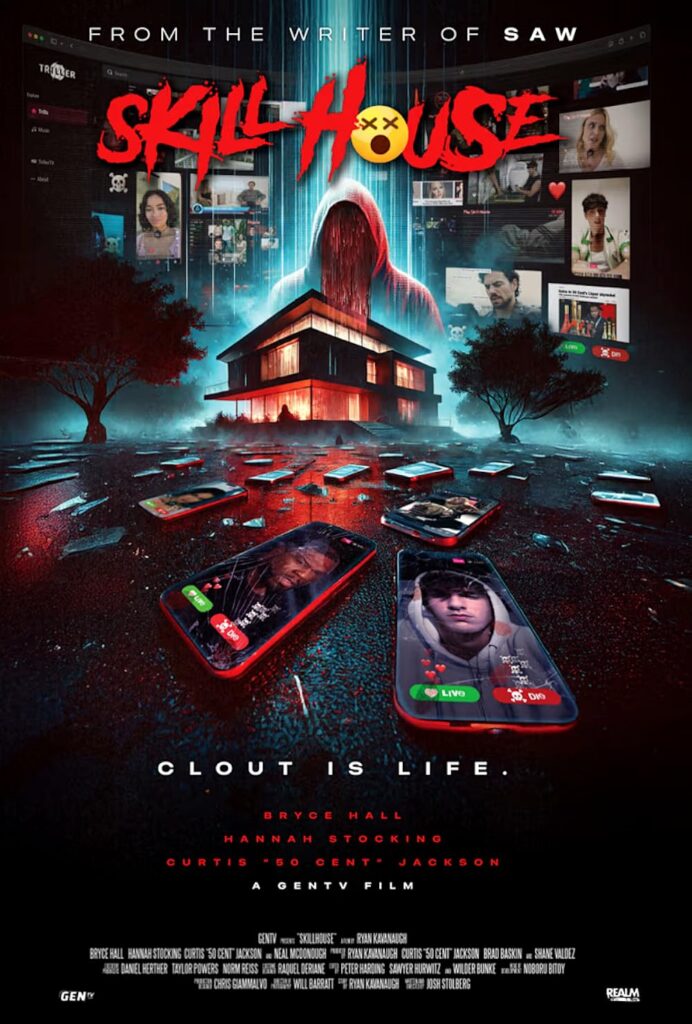The Skillhouse review reveals why this 2025 horror masterpiece delivers a brutal satire of social media culture. Josh Stolberg’s unflinching direction transforms familiar influencer territory into something genuinely terrifying and timely.
What happens when you combine the vanity of social media fame with the most deadly survival scenarios imaginable? You get horror perfection. Skillhouse (2025), directed by Josh Stolberg, stands as one of the most savage takedowns of influencer culture ever committed to film. This slasher horror follows ten popular influencers who are lured into a sinister content house where they must compete in lethal social media challenges to survive. While the film operates on familiar death game territory, it succeeds because it never holds back from exposing the toxic reality behind the perfectly curated feeds—every moment of horror serves the broader commentary on fame addiction and digital validation.

Synopsis
Ten of the internet’s most popular influencers, including rising TikTok star Hannah Stocking and YouTube personality Bryce Hall, receive invitations to an exclusive content house promising massive exposure and brand deals. What appears to be the ultimate collaboration opportunity quickly turns into a nightmare when the influencers discover they’ve been trapped in a deadly game orchestrated by a mysterious figure known only as The Algorithm.
Under the watchful eye of their captor, played with chilling intensity by 50 Cent, the influencers must participate in increasingly brutal social media challenges where likes, shares, and follows literally determine who lives and dies. With veteran actor Neal McDonough as the sinister overseer and Caitlin Carmichael as one of the younger victims, the cast must navigate a world where clout isn’t just currency—it’s survival.

Plot & Themes
Skillhouse operates on a deceptively simple premise: take every toxic aspect of social media culture and push it to its logical, deadly extreme. The death game framework serves as a vehicle for exploring deeper questions about fame addiction, the commodification of human behavior, and the psychological toll of constant online validation.
The film’s genius lies in its unflinching commitment to satire. When influencers are forced to livestream their own torture for views, the movie asks uncomfortable questions about what people will do for fame. These moments work because Stolberg approaches them with dark humor that exposes the absurdity of influencer culture without minimizing the genuine horror.
Thematically, the movie explores how social media has created a generation willing to sacrifice everything for digital validation. The influencers’ journey isn’t just about surviving physical challenges—it’s about confronting the emptiness behind their carefully constructed online personas.

Cinematography & Visuals
The cinematography captures the sterile, artificial atmosphere of influencer culture with visual techniques that serve the horror perfectly. The visual style contrasts bright, Instagram-perfect lighting with increasingly dark and brutal imagery, creating an aesthetic that mirrors the deceptive nature of social media itself.
The film excels in building tension through social media interfaces. The sequences showing real-time viewer reactions and comment feeds during the deadly challenges demonstrate innovative use of screen technology. The horror builds as audiences watch the influencers’ follower counts rise and fall with each brutal moment.
Product placement and brand imagery reward multiple viewings. Throughout the film, corporate logos and sponsored content become increasingly sinister, transforming familiar marketing tactics into instruments of psychological horror.
Acting & Characters
The cast of real influencers brings unexpected authenticity to their roles, with many essentially playing exaggerated versions of themselves. This meta-casting choice transforms what could have been stunt casting into genuine commentary on the blurred lines between performance and reality in digital culture.
50 Cent delivers a menacing performance as The Algorithm, bringing street credibility and genuine threat to the role. His scenes crackle with dark humor and calculated cruelty, making him a memorable horror villain who represents the faceless corporate interests that exploit young creators.
Neal McDonough provides excellent support as the corporate overseer, delivering his trademark intensity while adding layers of bureaucratic evil that make the horror feel grounded in real-world exploitation.
Hannah Stocking and Bryce Hall handle their roles with surprising depth, showing genuine fear and vulnerability that transcends their social media personas. Their performances suggest real acting potential beyond their influencer careers.
Direction & Screenplay
Josh Stolberg’s direction maintains perfect satirical balance throughout the film’s runtime. Coming from the Saw franchise and other horror works, Stolberg understood that effective horror satire requires precise tonal control. Every death is given weight while serving the broader commentary on digital culture.
The screenplay layers social criticism at multiple levels:
- Character development that exposes the psychology behind fame addiction
- Social media elements that feel authentic rather than generational pandering
- Corporate satire that targets real industry practices
- Horror set pieces that build organically from the influencer premise
The script’s structure follows death game conventions while subverting them through genuine cultural insight. This creates familiarity that makes the satirical moments land with greater impact.
Sound & Music
The film’s score perfectly balances trendy social media music with traditional horror orchestration. Popular TikTok sounds and Instagram-famous tracks become increasingly distorted and threatening, creating an audio landscape that mirrors the influencers’ psychological deterioration.
Sound design plays a crucial role in creating the digital nightmare atmosphere. Notification sounds, camera clicks, and streaming alerts become increasingly ominous as the horror escalates, turning familiar digital sounds into instruments of dread.
The use of silence during key death scenes deserves recognition. These moments are allowed to breathe without musical manipulation, trusting audiences to process the horror through visual storytelling and the characters’ genuine reactions.
Conclusion & Verdict
Skillhouse succeeds because it commits completely to its satirical premise while delivering genuine horror thrills. Every element—from casting to cinematography to sound design—works in service of both entertainment and social commentary without sacrificing either.
Strengths:
- Savage, timely satire of influencer culture and social media addiction
- Innovative use of social media interfaces and digital horror elements
- Strong performances from both professional actors and real influencers
- Excellent balance of dark humor and genuine scares
Minor Weaknesses:
- Some viewers may find the social media satire too on-the-nose
- Occasional pacing issues during exposition-heavy middle segments
This film remains essential viewing for horror fans and anyone interested in sharp social commentary about digital culture. Skillhouse works for audiences who enjoyed The Circle, Black Mirror, or Ready or Not.
Rating: 8.5/10
Director: Josh Stolberg
MPAA Rating: R (for strong bloody violence, language, and disturbing images)
Starring: 50 Cent, Bryce Hall, Hannah Stocking, Neal McDonough, Caitlin Carmichael, Leah Pipes
For more horror reviews, check out our analysis of other social media-themed thrillers. You can also explore the film’s cultural impact at the Internet Movie Database.


